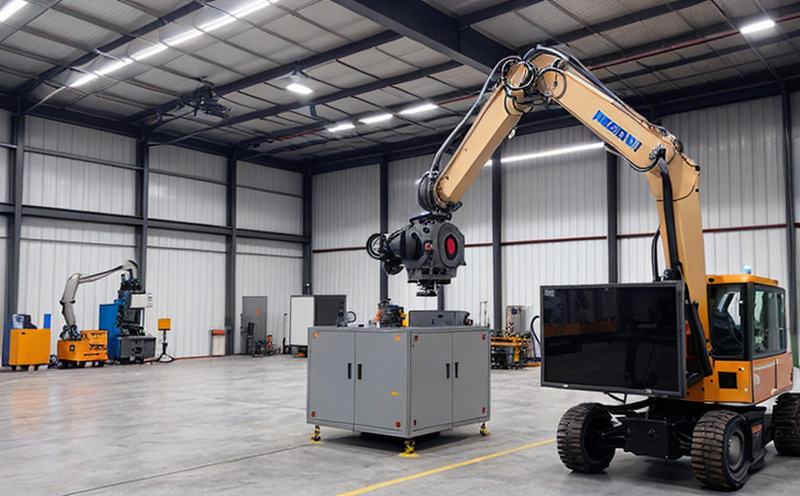ASTM F2217 End-Effector Motion Accuracy in Industrial Robots
The ASTM F2217 standard is a cornerstone for ensuring that industrial robots meet stringent accuracy and repeatability requirements. This test focuses on the end-effector motion, which includes the tooling attached to the robot arm. The primary objective of this testing protocol is to verify the precision with which an industrial robot can position its end-effector in space.
End-effector motion accuracy is critical for industries such as automotive manufacturing, electronics assembly, and food processing where high precision is paramount. Inaccuracies can lead to product defects, increased maintenance costs, and safety hazards. This testing ensures that the robotic system operates within specified tolerances, aligning with international standards like ISO 9283-1.
The ASTM F2217 test involves a series of steps designed to evaluate the robot's performance. These include setting up the test environment, calibrating the robot, and executing predefined motion sequences. The robot is subjected to various conditions that simulate real-world manufacturing processes. The end-effector position is then measured using high-precision sensors, allowing for accurate assessment.
The standard specifies acceptance criteria based on statistical analysis of the collected data. It defines acceptable ranges within which the end-effector must operate consistently. This approach ensures that any deviations from expected performance can be identified and addressed promptly. The testing process also helps in identifying potential issues during design and manufacturing phases, thereby improving overall quality control.
For industrial applications, maintaining consistent accuracy is essential for optimizing production processes. By adhering to ASTM F2217 standards, manufacturers can enhance productivity while minimizing errors. This not only improves product quality but also enhances customer satisfaction and operational efficiency.
Compliance with this standard is particularly important for companies looking to achieve certifications or meet regulatory requirements related to robotics technology. It provides a benchmark against which performance can be measured reliably across different models and manufacturers. Additionally, it supports continuous improvement initiatives by providing actionable insights into areas requiring enhancement.
In conclusion, ASTM F2217 plays an indispensable role in ensuring that industrial robots perform accurately and consistently. Its implementation ensures robust quality assurance practices throughout the manufacturing lifecycle, ultimately contributing to safer and more efficient operations.
Why It Matters
The precision of end-effector motion is crucial for various industries relying heavily on robotics technology. In sectors like automotive assembly, electronics manufacturing, and food processing, even minor discrepancies can lead to significant financial losses due to increased material waste or rework costs.
Compliance with ASTM F2217 helps ensure that industrial robots operate within strict tolerances, reducing the likelihood of defects in final products. This leads to enhanced product quality and improved customer satisfaction. Moreover, meeting these standards can help organizations secure important certifications and comply with regulatory requirements, which is increasingly critical in global markets.
From a broader perspective, accurate end-effector motion contributes significantly to workplace safety by minimizing the risk of accidents involving robotic systems. It also supports continuous improvement efforts by providing detailed performance data that can guide future enhancements. Ultimately, adherence to such standards fosters innovation and competitiveness within the robotics industry.
Applied Standards
The ASTM F2217 standard is widely recognized for its comprehensive approach to evaluating end-effector motion accuracy in industrial robots. This international standard provides guidelines on how to conduct tests that assess both positional accuracy and repeatability of the robot’s movements.
In addition to ASTM F2217, other relevant standards include ISO 9283-1 for general requirements related to robotic systems and their components. These complementary standards work together to provide a robust framework for ensuring consistent performance across different types of industrial robots used in various applications.
The acceptance criteria outlined by ASTM F2217 are based on statistical analysis, which ensures that measurements taken during testing accurately reflect the robot’s capabilities under real-world conditions. This method allows manufacturers and users alike to have confidence in the results obtained from these tests. Compliance with this standard is essential for achieving certification or meeting regulatory requirements pertinent to robotics technology.
By leveraging internationally recognized standards like ASTM F2217, organizations can ensure their robotic systems meet high-quality benchmarks. This not only enhances product reliability but also supports ongoing efforts towards continuous improvement and innovation within the industry.
Use Cases and Application Examples
The ASTM F2217 standard is particularly applicable in scenarios where precision and repeatability are critical factors, such as in automotive manufacturing, electronics assembly, and food processing. In these industries, even small deviations from expected positions can result in costly mistakes or safety hazards.
For instance, in the automotive industry, precise robotic welding requires flawless end-effector positioning to ensure uniform welds across all parts of a vehicle. Any inconsistency could lead to weak points that compromise structural integrity and increase manufacturing costs. By adhering to ASTM F2217, manufacturers can verify that their robots consistently produce high-quality welds every time.
In electronics assembly, accurate placement of components is vital for maintaining product reliability and performance. A slight misalignment during the placement process could result in shorts or opens, both of which are undesirable outcomes. Testing end-effector motion according to ASTM F2217 helps ensure that robots place components precisely where intended, reducing defects and improving overall yield.
Similarly, in food processing, robotic arms used for packaging must maintain consistent positioning accuracy to ensure products are placed correctly within containers. Inaccuracies here could lead to spills or damage during transport, increasing waste and operational inefficiencies. Implementing ASTM F2217 testing ensures that these robots operate reliably under all operating conditions.
Furthermore, aerospace manufacturing also benefits from stringent end-effector motion accuracy tests based on ASTM F2217 standards. The precision required in assembling complex parts like aircraft wings cannot be compromised; even tiny errors could have catastrophic consequences. By complying with this standard, manufacturers can ensure that their robotic systems meet the highest quality expectations.
Lastly, in medical device manufacturing, where sterility and accuracy are paramount, ASTM F2217 provides a reliable method for validating robotic processes. Ensuring correct positioning of surgical tools or components during assembly helps maintain stringent cleanliness standards while delivering precise results every time.





